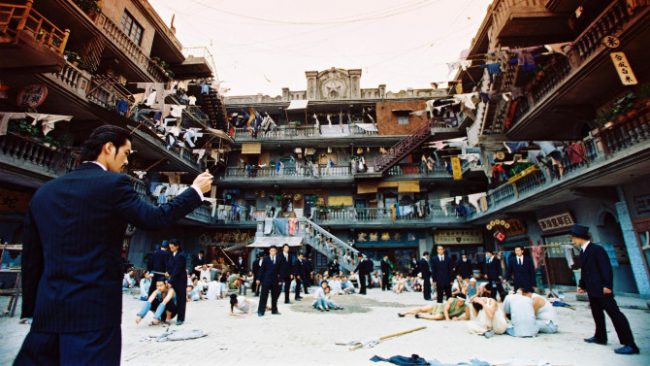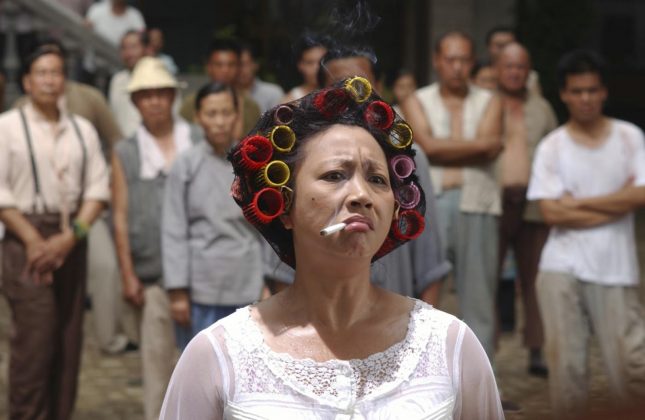
The Movie Tourist Visits Pig Sty Alley in ‘Kung Fu Hustle’ (2004)
Kung Fu Hustle is a 2004 action comedy set In Shanghai, China in the 1940s, where a wannabe gangster aspires to join the notorious “Axe Gang” while residents of a housing complex exhibit extraordinary powers in defending their turf.
“Away from the neon lit glitz and glamour of 1930’s Shanghai, is the slum apartment complex Pig Sty Alley, which is not only ruled with an iron fist by the landlady but also secretly serves as a retirement home of sorts for old kung fu masters”
After exploding on the radar of western movie-going audiences with Shaolin Soccer, director and leading man Stephen Chow aimed with this film to follow its success, and despite turning a profit of $102 million on a budget of $20 million, Chow bizarrely dropped from the radar almost as quickly as he’d appeared. Despite continuing to produce further films in his native Hong Kong it was only with 2016’s The Mermaid getting a limited release that most Western fans were even aware that he was still working.

Drawing inspiration from the Kung Fu movies he watched as a child, this fueled his ambition to become a martial artist. Pig Sty Alley would be the first location he created, drawing inspiration from his childhood home in a crowded apartment complex in Hong Kong. Chow would also take further inspiration from the Shaw Brothers The House of 72 Tenants which not only was the top grossing film of 1973 in Hong Kong, surpassing Enter the Dragon, the film also significantly changed the way films were made in Hong Kong thanks to director Chor Yeun shooting the film in Cantonese at a time when films were being shot predominantly in Mandarin, though the success of this film saw studios switching their focus so that all major films were made in Cantonese, a tradition that continues today.
Pig Sty Alley though is a startling contrast to the neon glitz and glamour of 1930’s Shanghai, which here is shown being dominated by the Axe Gang who with their top hats and black suits are introduced in the opening sequence like a scene torn from a Fred Astaire musical only trading out their canes for axes. The gang perfectly matches this backdrop of wealth and fortune, making them as well the perfect opponent to the poverty stricken residents of this slum apartment block who are quite happy making do with what they have. Still this isn’t the first appearance for this gang of sharp dressed gangsters who have made several appearance in Hong Kong cinema since first appearing in films such as Boxer From Shantung and Project A Part 2 though its in Chow’s hands they are easily at their most memorable.

What really makes Pig Sty Alley special though is in the casting of its residents, which looking at the cast list, could almost be viewed as a retirement home for former stars of Kung Fu cinema, starting with Yuen Qiu as Landlady who is unquestionably the character who comes to mind first when you think of the film, constantly clad in her nightie, cigarette in mouth and hair in rollers while holding a general disdain for anyone who is stupid enough to cross her. It’s of course ironic that her casting would be completely be by accident when she turned up to support her friends screen test only to be spotted smoking a cigarette, which would lead to her landing the role and breaking her retirement of nineteen years after filming Disciples of the 36th Chamber.

Joining Yuen Qiu is Yeun Wah as Landlord whose career has seen him not only working as Bruce Lee’s stunt double in Enter the Dragon and Fist of Fury, which is where he made acting debut. Wah was also a member of the Seven Little Fortunes alongside Jackie Chan, Sammo Hung and Yuen Biao who he attended the China Drama Academy with and would spend a large portion of his career facing off against as a villain making this a rare good guy role for him.
Rounding out his cast of Kung fu legends is Bruce Leung as the Beast who was cast by Chow who was keen to work with his childhood hero, despite the fact that Leung had officially been retired since 1988’s Ghost Hospital. However while perhaps not the most recognisable actor to western audiences, Leung at the height of his career was referred to as the third dragon behind Bruce Lee and Jackie Chan the former whose career he essentially launched, working as one of the key actors in the Bruceploitation genre, films which would either utilise Bruce Lee lookalikes or having actors rebranded using similar sounding names such as Bruce Lai, Bruce Le and Dragon Lee. Leung starred in arguably the most random of these films with the Dragon Lives Again which saw Bruce Lee sent to hell where he fights James Bond, Clint Eastwood, Dracula and a bunch of mummies.

While Chow clearly is keen to tap into films he grew up with for casting and inspiration, throughout Kung Fu Hustle, he shows himself equally keen to draw from more contemporary movies, from the subtle nods such as the sharpest assassins wearing Blues Brothers style sunglasses and fedoras through to the large-scale fight scenes between the residents of Pig Sty Alley and Sing (Chow), which see them battling hundreds of gangsters at the same time bringing back memories of Quentin Tarantino‘s House of Blue Leaves fight scene between the Bride and the Crazy 88’s, even using actual actors for the fight scenes and exaggerating them through CGI, which fits the style of the film without losing any of the presence. This was also the case in the Neo vs 100 agent Smith’s in the Matrix Revolutions. It should be noted though that all three films were fight choreographed by the legendary Yeun Woo-ping who took over from Sammo Hung, who quit the film two months into the production due to a combination of illness and general issues with both the production crew and tough filming conditions, so similarities between the three can be expected but despite this he still brings a style inventiveness to the fight scenes that we usually find in Jackie Chan’s films as everyday objects are utilised in the fights while still maintaining the flow of the fight sequence, most notably seen here during the reveal of the three kung fu masters who work elements of their day jobs such as poles used for rolling dough and curtain rings into their fighting style.
While there are scenes filmed in Chow’s vision of Shanghai, its the scenes that are filmed in Pig Sty Alley that are surprisingly the strongest, especially for such a minimalistic environment. However, here there is great delight to be found in meeting the many colourful residents even those who aren’t secret kung fu masters. The large open forecourt also gives plenty of space for the fight scenes which are usually on mass as the Axe gang apparently can’t do anything without sending at at least 50 gangsters, though with Yeun Woo-ping’s inventiveness by the finale it seems that Sing has battled throughout the whole complex.
It’s still baffling why this film didn’t inspire Chow to release more films for Western audiences especially when it was so warmly received by critics and audiences alike with The Mermaid only recently breaking the trend even if it was a limited release. Still with Pig Sty Alley he has created not only a throwback to the classic kung fu movies of his past but also showing a Tarantino style talent for subtitling, reviving the careers of the Hong Kong legends who inspired his own career. However when it comes to memorable locations in his filmography Pig Sty Alley is an essential stop off for any movie tourist.
